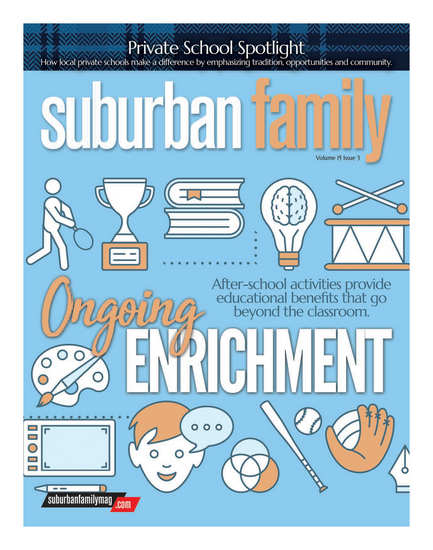
The time is now to strike that balance between academics and extracurricular activities and get noticed by the college of your dreams.
We know parents wish for nothing more than health and happiness for their children, but let’s face it—they may also be feeling the increased pressure to groom their kids along the way for acceptance into a top college or university.
The trouble is, even if a student does all the right things—from earning good grades and scoring well on the SATs to participating in extracurricular activities and volunteer work—that doesn’t necessarily mean they will earn a spot at their top-choice institution. “Everyone says you must have the right grades, the right extracurriculars, the right hours of volunteering … but then we’d all be the same,” says Nicole Katchur, 17, a senior at Clearview Regional High School in Mullica Hill. “In reality, colleges want diverse students—the ones who don’t follow a trend.”
So which is it? Should students aim for that valedictorian address? Opt for pages upon pages of student activities? Forge their own path?
Suburban Family went straight to the source to get to the bottom of what colleges and universities are really looking for—and how students can help secure their future long before they turn that tassel on graduation day.
Changing times
College admissions offices have been receiving a climbing amount of applications to fill the same steady number of seats for years, explains Rodney Morrison, associate chancellor for enrollment management at Rutgers University – Camden. That means students have to work harder to make a good impression.
As such, public institutions—like Rutgers and Rowan University—are going out of their way to attract New Jersey-based students. “New Jersey’s public institutions have made enormous strides in increasing their reputations and desirability to our state’s students,” says Al Betts, director of admissions at Rowan. “As a result, not only have the number of applications for admission greatly increased at our public schools, but the academic quality of the applicants has also increased dramatically.”
According to Betts, public schools are generally more competitive than private schools because of the larger number of applications they receive—but it’s the prestigious private schools that remain the most unattainable for students.
To gauge a student’s chances of being accepted at a particular college or university, high schools throughout the area are providing access to Naviance, a computer program that uses past statistics to give students, guidance counselors and parents a realistic look at their odds.
Changes to the application process that could affect admission rates include the new SAT scoring to accommodate the writing section, students being given the opportunity to self-report grades on their applications in place of submitting official transcripts, and the option of taking either the SAT or ACT for admission.
One thing is certain: Applying to college is a very different process now than in past decades.
Stand-out students
The question on every student’s mind: What do they need to do to earn that big acceptance package in the mail from their first-choice college?
While acceptance standards and qualifications vary from school to school, most colleges and universities still evaluate students based upon several factors, including: grades, especially those earned in Advanced Placement (AP) courses; standardized test scores such as the SAT/ACT; extracurricular activities; and volunteer work.
Whether they’re public, private or Ivy League, all colleges want to attract students who will positively contribute to the campus environment. That’s why participating in extracurricular activities during high school remains one of the best ways for students to prove that they will add value to the campus environment through their personality, skills or talents.
“Colleges like to see that students have a life and are involved and engaged after school hours,” says Darren Gamel, a guidance counselor at Cherry Hill High School East. “A good number of colleges would prefer the less-than-perfect student who has somehow contributed to their high school environment, because they know those are the students who will do the same thing for their institution.”
However, guidance counselors overwhelmingly agree that students shouldn’t stretch themselves too thin between athletics, extracurricular activities, volunteerism and part-time jobs during their high school career just to attract the attention of college admissions departments.
There has been a shift in just how many activities colleges want to see listed on a student’s resume, according to Cara Buckland, director of guidance at Gloucester Catholic High School. These days, less may be more when it comes to checking those boxes on a college application.
“Five or 10 years ago, it was about playing a sport, doing community service, and being in the drama club, but the more recent trend is that colleges want students who have a focus. That commitment to one activity over a long period of time translates to perseverance and the ability to reach short- and long-term goals,” she says.
Colleges aren’t asking students to have 100 activities; they’re asking students to make a commitment and demonstrate their dedication to something, counselors say.
Another quality that will help students stand out in a sea of applications is leadership, so students should always consider pursuing activities that they can commit to for the long haul and eventually assume a leadership position—or better yet, they can create their own opportunities within the community.
“Colleges are looking for key indicators that will help them assemble the class they want to create, and most want students who are community service-oriented,” says Dennis Murphy, vice president for enrollment and student affairs at Neumann University in Aston, Pa.. “But they’re also looking for students who possess leadership qualities and know how to take initiative.”
Another way to demonstrate commitment is by enrolling in AP or honors courses early on in high school, Murphy says, because it’s a way to demonstrate dedication to their education throughout their entire high school career.
Parental guidance
Many advise parents to take a hands-on approach when embarking upon the college process. That could mean getting to know your child’s teachers and guidance counselors on a first-name basis.
The pathway to that coveted acceptance letter also involves encouraging students to think very carefully about what they’re looking for in a college, being realistic about what they can afford, and, ideally, applying to approximately three to five schools that include a dream and safety school. It’s also a good idea not to get too wrapped up in “name brand” schools, counselors say, not only because of their hefty price tag but because they may not be the right fit for every student.
“Students and their parents should always look beyond the name and their general impressions about a school to find the best match,” says Meredith Godley Hanamirian, director of college guidance for Moorestown Friends School.
One of the biggest mistakes a student can make is waiting too long to begin their college search—or missing application deadlines all together.
With five children, the youngest of whom is a junior at Sterling High School, Stratford resident Joseph Mottola knew he had to help his kids get organized when it came time to apply to college.
“The biggest challenge students face is meeting deadlines … but if they complete the application process by mid-November, his or her chances of gaining acceptance and attaining scholarship money increases dramatically,” he says.
The college application process doesn’t have to be as daunting as it seems, provided students take the time to learn about themselves and about each college on their list to ensure that the student’s needs match the college—and vice versa.
Published (and copyrighted) in Suburban Family Magazine, Volume 3, Issue 6 (August, 2012).
For more info on Suburban Family Magazine, click here.
For information about advertising in Suburban Family Magazine, click here.
To find out where to pick up your copy of Suburban Family Magazine, click here.




